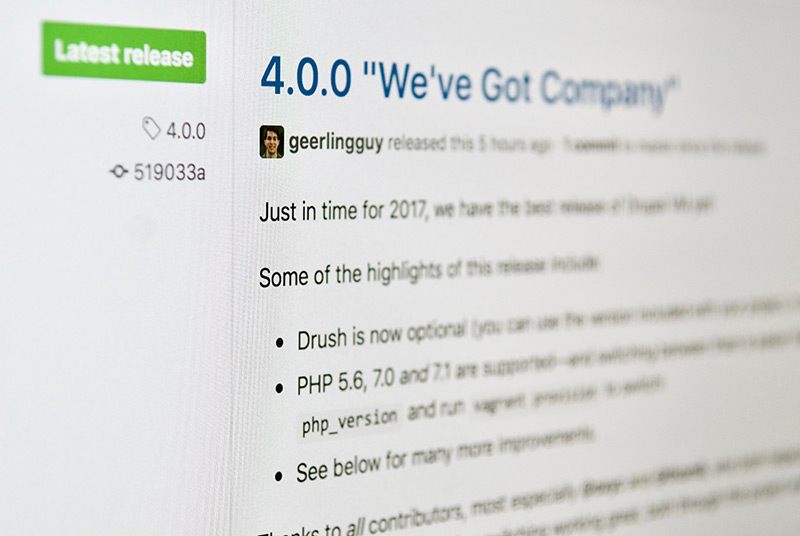
Seven months after Drupal VM 3 introduced PHP 7.0 and Ubuntu 16.04 as the default, as well as more stable team-based development environment tooling, Drupal VM 4 is here!
Thanks especially to the efforts of Oskar Schöldström and Thom Toogood, who helped push through some of the more tricky fixes for this release!
If you're not familiar with Drupal VM, it's a tool built with Ansible and Vagrant that helps build Drupal development environments. The fourth release brings with it even more flexibility than before. Not only can you choose between Ubuntu and CentOS, Apache and Nginx, MySQL and PostgreSQL, Memcached and Redis... you can now seamlessly switch among PHP 5.6, 7.0, and 7.1—without having to recreate your entire development environment!
See the 4.0.0 release notes for all the details—here are the highlights:
- Drush is now optional (you can use the version included with your project, or not use it at all!)
- PHP 5.6, 7.0 and 7.1 are supported—and switching between them is easier than ever. Just update
php_versionand runvagrant provisionto switch!
Download Drupal VM and try out one of the most popular Vagrant-based development environments.
Comments
Hi Jeff, I installed Drupal VM on my Windows 7 desktop for testing as a development platform for upgrading a legacy Drupal 6 site, but found that the hyper-V overhead was just too slow. Are there instructions anywhere for uninstalling DrupalVM, Ansible, Vagrant, and any other project dependencies? Thanks.
For Drupal VM itself, you can just delete the Drupal VM directory on your drive (after running
vagrant destroy -fto remove the VM). To uninstall Vagrant, you can use Vagrant's uninstall utility (included with Vagrant's downloadable installer). You can also try out VirtualBox as the VM host (instead of Hyper-V) to see if it's any better. Ansible would only be installed within the VM, so no need to uninstall it (it's gone when you delete the VM).Thanks for the quick response, excellent software, and great documentation, Jeff. I thought that the vagrant install might somehow be overriding legacy SSH keys and interfering with Chrome's Secure Shell plug-in, but it turned out that an undocumented feature of the SSH plug-in was retention of obsolete server credentials. By the way, I was speaking generically when I mentioned Hyper-V. Your Drupal VM sample project instantiated just fine after upgrading my install of Virtual Box v 4.x to Virtual Box v 5.1.10. I don't know whether the slow program responsiveness is due to limited PC horsepower (AMD Phenom II x4 840 @ 3200 MHZ w/8GB RAM) or virtualization overhead, but because my current project is a Drupal 6 to 7 migration, I decided to use a dedicated Centos 7 Server on my home LAN as the Drupal 7 development platform. I'll keep the Drupal 8 VM instance to compare D6-D8 VM migration potential versus my D6-D7 experience on the dedicated PC. Thanks again for all the Drupal community contribution.
Drupal VM is just making it too easy! Thanks Jeff.
Hi Jeff,
I have a Hyper-V 2012 Server and would like to host a Drupal 8 VM. All of the VMs are created and manged using a tool called Hyper-V Manager. Is it possible to use DrupalVM to create a Drupal VM to host in Hyper-V 2012 Server?
Thanks
Jon
@Jon - That may be possible, but I haven't ever used Hyper-V on Windows, only VirtualBox. Someone else would likely have a better perspective on it. Note that Vagrant does support a Hyper-V Provider, so it might just be a matter of setting the right
vagrant_boxand adding some configuration in aVagrantfile.local.